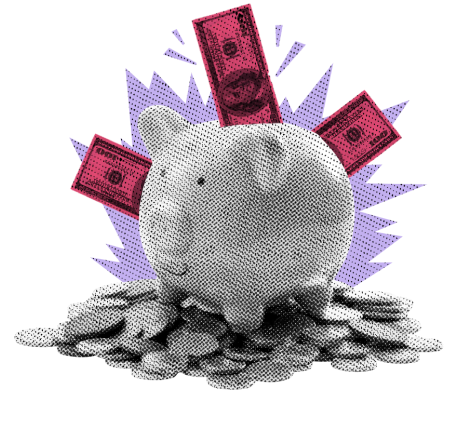
Economic warning signs mount, even if the headlines seem slow.
KEY TAKEAWAYS
- Leading Economic Index fell -1%, a rare and notable drop.
- Jobless claims stayed strong, hurting hopes for Fed rate cuts.
- Manufacturing PMI beat expectations, staying above 50.
- Retailers split on handling tariffs—Home Depot to absorb costs, Lowe’s will pass them on.
- Moody’s downgrade and weak Treasury auction triggered a bond selloff and revived 1980s-style bond vigilantes.
MY HOT TAKES
- Markets are obsessed with weak data—but not getting it.
- Tariffs are distorting corporate decision-making and margins.
- Deficit fears are real but already priced in—Moody’s was late.
- Home Depot’s tariff strategy is rational, risky, and worth watching.
- Bond traders—not the Fed—are setting the tone now.
- You can quote me: “We end the week having emerged from one dark forest, only to find ourselves back in the much larger dark forest of trade and tariffs.”
Sir, may I have the bill? The economic release calendar was sparse this week, but the week was hardly devoid of information that can and will affect the US economy, and perhaps beyond. You’re thinking, “wow that was a big statement!” Indeed, it was my intention… for literary effect. Do I have your attention? Great, let’s get into it.
Before I get to the big stuff, let’s have a look at some of the lesser but still important bits that impacted the markets. The Leading Economic Index fell by -1% continuing its losing streak that began in January. The index which is supposed to be a predictor of economic health was held back by continued weakness in equities, weak manufacturing orders, and consumer sentiment. For some context, this index only fell by -1% or more 13 times in its history since 1958.
A strong labor market is ½ of the Fed’s mandate, and FOMC members have made it clear that it is watching unemployment closely to inform them on their next move. New weekly unemployment claims give us a timely clue about conditions in the labor market, and yesterday’s number showed little sign of weakening, coming in better than expected. This can be a volatile number, so we like to look at the print relative to its 4-week simple moving average. This week and last week’s Initial Jobless Claims releases were less than the average, which indicates improvement. Remember, less unemployment claims is good for the economy–maybe not so good for investors obsessed with Fed rate cuts. Looking at a broader horizon, 10 releases were below the moving average and 10 above. While that may seem inconclusive, an even split can be viewed as positive in a market regime that is in search of weak numbers. Let me explain. Bears certainly, and even bulls are looking for signs of economic weakness to inform their trading. Recently, it appeared that the bears are looking for weakness for vindication that the new Administration is wrecking the economy, and bulls are looking for signs that would indicate that the Fed may step in and lower rates and help push markets higher. Neither will go home satisfied this week.
Another important number this week was S&P Global’s flash Manufacturing PMI. Purchasing Managers Indexes are a great way to gauge corporate sentiment. Managers are surveyed on current conditions, future expectations, and plans. Earlier this week, I wrote about how firms are rational and operate without emotion, and these indices give investors a look into what those emotionless companies are thinking–not feeling. All that means that they are important numbers to watch. Remember, unemployment almost always portends recessions, and companies are responsible for employment. So, well… you know. You have probably heard that the US is a service economy, and the numbers support it. According to the Bureau of Economic Analysis, only 9.9% of GDP comes from manufacturing. So, why would we care about manufacturing PMIs? First of all, EVERY economic number is important, and if 10% of GDP went away, it would not be pleasant–it would leave a mark. But Manufacturing PMIs have been front and center recently because traders are trying to find signs that tariffs and trade tensions are impacting the economy, and most of the tariffs impact manufacturers. That said, yesterday’s number showed a month over month increase which exceeded economist’s estimates. With PMI’s prints above 50 indicate expansion while prints below contraction. Manufacturing PMI has been consistently above 50 since January despite being mostly below since late 2022.
Tariff impact has been a major market theme since the President announced his first tariffs only days after his inauguration. We all know the impacts tariffs can have on manufacturers as their supply chains are highly reliant on foreign imported materials and parts. Retailers are also heavily exposed to imports, and this past week we got Q1 earnings releases from a number of large US Retailers, including Home Depot, Target, and Lowe’s. While Home Depot and Lowes topped estimates, Target missed by an uncomfortable margin, but it was not Q1 performance that we were interested in. We are interested in guidance and how tariffs or economic conditions might affect sales between now and year end. Target lowered its guidance, blamed tariffs, and warned about price increases. Home Depot and Lowes both reaffirmed their earlier guidance. Both acknowledged that tariffs would have material impact. Interestingly Home Depot effectively promised not to pass increased costs on to the consumer, hoping to use the event to gain market share from price-conscious investors. Their principal competitor Lowe’s, with 20% of its products imported from China, warned of price hikes to consumers. Home Depot's gambit may pay off, but it will come with a cost–lower margins.
Finally, let’s get out of the trees and have a look at the forest–this big theme of the week. This week’s forest is all about the federal deficit and the mounting pile of US debt. After last Friday’s close, Moody’s became the last of the three major credit ratings agencies to lower the US’s rating to one below perfect. The reason for the late downgrade, according to Moody's, was the already large $2 trillion (with a T) trade deficit that was expected to rise further with the pending Republican-led tax legislation. This is not a new issue. In fact, late last year, even prior to elections, bond traders pushed Treasury yields higher in anticipation of the massive promises made by both candidates–both promising to swell the deficit. The move stymied investors who were hoping for lower yields after the Fed began to cut rates, but they got the opposite. The issue took second seat to inflation and tariffs soon after. Though yields receded somewhat, they remained elevated.
The market’s response to Moody’s downgrade was muted at best, as markets had already factored in the deficit and debt. The move was also largely expected. However, the debate was far from over. On Wednesday, the Treasury auctioned off 20-year bonds, and the reception was weak. Demand for the auction caused the bonds to be awarded at yields far higher than the market at the time of the auction. This caused treasuries to sell off bringing 10-year notes to the brink of the important 4.60% level and pushing Long Bond (30-year) yields over 5%. Those are critical, technical resistance levels. The move capped off a yield rise that was ongoing, likely brought on by 80s-style bond vigilantes. By 1980s-style I don’t mean that they wear neon and have big hair, but they do take a book out of 1980s bond traders that famously pushed yields higher in protest to Reaganomics-induced deficit bumps and high inflation. Sound familiar? Because it is.
The selloff in bonds caused equities which all but pulled up the emergency brake on what was a pretty strong winning streak that began to lose energy a day earlier. Though many would attribute the selloff to the deficit issues, it is more likely that stock traders were looking for a reason to take profits after a solid run that left stocks somewhat overbought. Yesterday’s rather subdued market action suggests that the issue has been dealt with. In other words, markets have now factored in the deficit and rising. That is also why there was little reaction to the House passing the very bill that “forced” Moody’s into action.
So, we start our final trading session of the week with futures pointing to a negative close. Most of the losses came early this morning with Trump announcing that he would charge Apple with at least a 25% tariff if it did not produce its iPhones in the US. To make matters worse, minutes later, the President threatened to place a 50% tariff on EU imports. The EU is reportedly preparing counter tariffs. The news caused futures to sell off sharply.
So, we end the week having emerged from one dark forest, only to find ourselves back in the much larger dark forest of trade and tariffs. Trading days prior to holiday weekends are generally biased to positive with low volume. As with all things in the markets, norms are made to be challenged. Tune back in next week for another forest to traverse.
YESTERDAY’S MARKETS
Stocks had a flat-ish close yesterday after meandering about throughout the session. Traders were still reeling from Wednesday’s sloppy 20-year Bond auction and wondering if it even mattered for stocks. The House voted to advance the One Beautiful Big Bill to the Senate chamber where it will be heavily scrutinized; markets shrugged it off. Business sentiment unexpectedly gained, according to S&P Global's flash PMIs. 🤨

NEXT UP
- New Home Sales (April) may have fallen by -4.0% after a 7.4% gain in March.
- Fed speakers today: Goolsbee, Musalem, and Cook.
- Next week: believe it or not there are some really important earnings announcements next week that can have their way with your portfolio. In addition, some critical economic releases are on the calendar; expect Durable Goods Orders, more housing numbers, Consumer Confidence, FOMC Minute, GDP revision 2, Personal Income, Personal Spending, PCE Price Index, and University of Michigan Sentiment. Markets will be closed on Monday for Memorial Day 🫡 but check back in on Tuesday to get your weekly schedules so you can make your friends jealous and be first in line.
.png)

